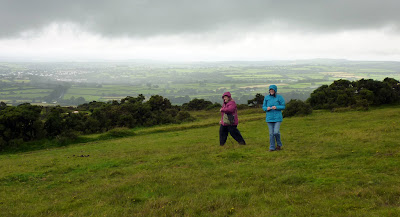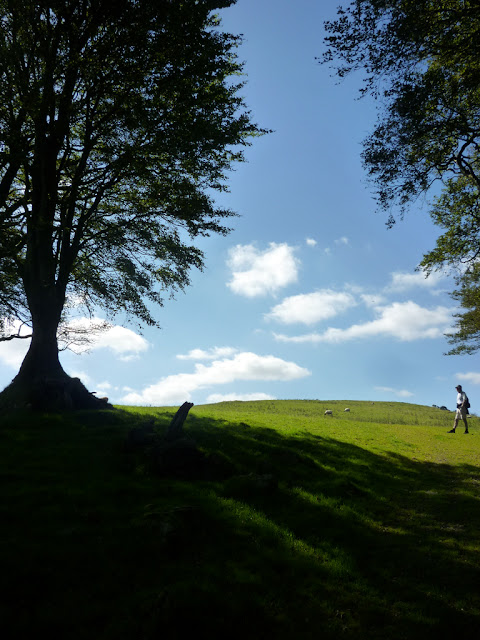A resolute spirit and the right layers of clothing are a good starting point for winter wandering in the wilder parts of Dartmoor.
The truth of Ranulph Fiennes line, " There is no bad weather, only inappropriate clothing", soaked in as we set off from our cosy rented barn conversion in the aptly named hamlet - Water, in S E Dartmoor.
It's always a pleasure coming back to a warm home, but leaving it in the wild, wet, windy-cold calls for the spirit of Shackleton to muster up forgotten courage as the blast of winter comes leaking past the opening front door.
Heading down the soggy garden and into the misty woods bordering the Lustleigh Cleave,we thought a little recce would be in order before attempting a full-blown walk, but we quickly got sucked in - the spooky woods had woven their icy spell!

Walking further into the woods, the muddy track became a narrow path, and the mists surrounded us in their own other-world. Silhouettes of tree trunks, branches, bushes all in near monochrome, merging and moving in the wind that we could hear above us but hardly feel, the shelter of the misty woods embraced everything, almost warmly, like an old country welcome in a wet hallway. It was nostalgic to ease into this dim world that reminded me of exciting pre-teen forays in the thick jungle close to our backyard in the Far East, where I was born so long ago.

This was midday and 4 hrs to dusk. In the half-light a stone's throw away to the left... a boar, or a deer, not a Bigfoot - reported seen in these valleys - I hoped, phew.... again just another bush changing shape in the blurry murk. (Read more at this link - https://www.legendarydartmoor.co.uk/big_foot.htm) The path turned right to skirt the wood, and for a while opened up views of the outside world and another reality, with red autumn foliage washed in blotches across far away hills, leafless trees naked to the right, and partly-clothed conifers to our left. Weeks of daily rain had soaked the topsoil, water running across the surface of everything. Praise the inventor of modern waterproof boots...the Roman legionnaires must have been tough...walking to these parts from all the way from across the Alps wearing leather thongs.....at least they didn't need to carry their water here! ....."da mihi Hispaniam rursus (give me Spain again)!"
Just as the path we were on turned back into the conifers, I caught sight of a well camouflaged heaven built by someone obviously wealthy and wanting to enjoy the solitude.
An 'eco-house' on the edge of a misty wood must be a dream come true if you can find a plot, afford the build, and be self-sufficient enough to enjoy the quiet, peace and solitude. As the afternoon ticked away we decided to come back to our walk the following day, and turned to head home. Our local pub was 400 yds away and the ideal place for dinner as we had brought only basic stuff, planning to head to the shops in Moretonhampstead the next morning for more foodie (and drinky) supplies. Basic pub food becomes a little feast when its cold outside and there's a roaring fire to watch between courses. We sampled more beer than we should have but our hired home was only a short way away through the dark and drizzle, and back to a warm shower, glass of wine and comfy beds, zzzzzzzzzzzzzz.
Early next morning it was raining so heavily that we couldn't see the next field through the roof windows. As the sun crept above the tree-line the mist started to clear slightly and it was time for a 2nd foray into the Lustleigh Cleave. Back on with the 3 layers of warm woollies and the waterproofs, and our thick socks and walking boots. Out into the cold and via another path we headed downhill towards the river Bovey that cut the cleave zillions of years ago.
Most of the valley is thickly wooded and not many people live beyond the occasional sub-hamlet dotting the road between Bovey Tracy and Moretonhampstead. Paths that weave down to the river must have been tracks that villagers used to carry their water before the days of pipes and taps. Too poor to have a well dug, a bucket or two a day would have to suffice and fetching it must have been a major feat for the elderly - nearly 10lbs per gallon, 3 gallons per bucket....uphill in the mud!! Poor folk were mostly fit into their final years, and it was sickness or accidents leading to reduced mobility that probably took more old lives than natural old age. There are still old folk living in the wood like their forefathers, almost fused with the woody setting, and as we slipped and sloshed through the woods, down towards the sound of rushing water, we passed a few homes in a near-inaccessible setting. The occupants were probably elderly, and we could see from the repairs that had been made to the houses, that simple 'forest DIY' was the order of the day - no Wickes preserved timber and mild steel bracketry patching up the dilapidated porches and window frames, just wood weathered white with age and ofttimes gathered branches, never straight, but doing the job well. No wrecked cars or old rusty motorbikes, just old cast iron farm implements and firewood gathered on the way back from who knows.......
This must have been a popular track down to the river as an old signpost, just discernible, points down into the green gloom, and we follow, slipping on the mud and streams that flow across the surface. Broken branches of trees take on alien forms, like wormy predators reaching out for a midday snack as we pass, our eyes wide and searching the mists for signs of any scary stuff hiding in the undergrowth.


We know that we're safe really, but the story of the witch's house in Hansel and Gretel is easy to envision in this setting. As we get to the bottom of a long slippery slope, the sound of the river is very close, but the undergrowth becomes impenetrable and unless one has something to cut and clear with, it's going to be hands and knees stuff, and we run out of the Shackleton spirit. Mainly urban children of the mid 20th century we just don't have the physical drive to crawl around in the mud during a holiday walk.

We head back uphill again. A quick change of plan and we divert back up another long narrow path that turned into a little stream weeks ago, still walkable but rather boring compared to the wild conifers.

It leads us up to a village called Manaton, and it's famous church St
Winifred's that has a 500 year old bell-tower, rent in two by a
lightning strike in 1779, but now rebuilt with the original bells
restored to their proper place.
Civil war stories abound in these areas, and the rood screen in this church, now restored, was badly defaced by Cromwell's troops. The churchyard bears solemn witness to the brave young villagers whose lives were lost to two world wars - they really thought that they were fighting to rid our ever more ghastly world of evil. They could have stayed at home and enjoyed the village life but were honour-bound to do what they thought was the right thing. Same story repeated countless times in countless villages all over the world, and still, brave folk fight for what are their rights, and are repeatedly thwarted by ruthless, faceless power - people and organisations who wouldn't even bother to discover the beauty and spirit of the ordinary country and folk who live there.
Climbing up beyond the graveyard into the Manaton Rocks - a popular location for rock climbers, where according to the darker tales of local history in these parts, centuries ago during the civil war, Royalist cavaliers hid in caves in an attempt to escape from the attacking Parliamentarians but were hauled out, mutilated and put to the blade. Inevitably, despite being amidst the beauty of this region, one is led to reflect on the years of conflict between the Puritans and Catholics - broadly the same faith to the likes of me, and how that has formed the history of much of the country. Village set against village and due to what now seems like a small difference in doctrine, horrific behaviour consumed the lives of countless otherwise innocents.
The path up to the rocks took us through an ancient Dwarf Oak forest that is extremely damp, and such damp and cool mini eco systems enourage the growth of a beautiful fungus (Usnea) that has been found to possess proven theraputic qualities. Also known as Old Man's Beard, it's an indicator of clean-air quality so is gradually becoming rare in our modern polluted world.




Looking SW from the Manaton Rocks, about 2 miles away, across a valley lies the famous granite outcrop known as Bowerman's Nose - even from here, the profile is clearly visible like a person with a long nose wearing a flat cap - the legendary hunter who while chasing a hare with his hounds, inadvertently overturned a witch's cauldron while the coven were casting a spell, and being cursed for his actions, turned into stone, along with his hounds - the lucky horse escaped!
Many of these wonderful tales are now almost forgotten, and the more popular now preserved by enthusiastic amateurs - if you are interested, some parts of this well signposted website might be worth a browse: http://www.legendarydartmoor.
The days passed as we wandered round the Lustleigh Cleave and surrounding villages that are less familiar to us as those in the northwestern side of the moor, and we saw some strange sights which are difficult to interpret. One of them appeared to be an apparition the size of a youngster, standing in the benches of a side chapel in St Andrews of Ashburton, partly refletive, partly transparent and standing still, it seemed like an instant puzzle. I never found out what it actually was. Outside the same church, in the middle of the churchyard is a magnificent celtic gravestone, well worth a mention/picture here.
Soon we were packing to head home and promising ourselves that we'd be back again soon - as we always do, because Dartmoor is endlessly fascinating, very empty, and great walking country where the horizons are never obscured for long and where most of the beer and food tastes very good indeed. We always hope that people who wander through keep it a well treasured secret, and that it never becomes a mass tourist destination - not in our lifetime anyway.
















































































